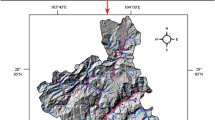Abstract
The Wenchuan earthquake on May 12, 2008 caused numerous collapses, landslides, barrier lakes, and debris flows. Landslide susceptibility mapping is important for evaluation of environmental capacity and also as a guide for post-earthquake reconstruction. In this paper, a logistic regression model was developed within the framework of GIS to map landslide susceptibility. Qingchuan County, a heavily affected area, was selected for the study. Distribution of landslides was prepared by interpretation of multi-temporal and multi-resolution remote sensing images (ADS40 aerial imagery, SPOT5 imagery and TM imagery, etc.) and field surveys. The Certainly Factor method was used to find the influencial factors, indicating that lithologic groups, distance from major faults, slope angle, profile curvature, and altitude are the dominant factors influencing landslides. The weight of each factor was determined using a binomial logistic regression model. Landslide susceptibility mapping was based on spatial overlay analysis and divided into five classes. Major faults have the most significant impact, and landslides will occur most likely in areas near the faults. Onethird of the area has a high or very high susceptibility, located in the northeast, south and southwest, including 65.3% of all landslides coincident with the earthquake. The susceptibility map can reveal the likelihood of future failures, and it will be useful for planners during the rebuilding process and for future zoning issues.
Similar content being viewed by others
Reference
Aleotti P, Chowdhury R (1999) Landslide hazard assessment: summary review and new perspectives. Bull Eng Geol Environ 58:21–44.
Binaghi, E., Luzi, L., Madella, P., 1998. Slope instability zonation: a comparison between certainty factor and fuzzy Dempster — Shafer approaches. Natural Hazards 17, 77–97.
Chung, C.F., Fabbri, A.G., 1993. Representation of geoscience data for information integration. Journal of Non-Renewable Resources 2(2): 122–139.
Chung C-JF, Fabbri AG (1999) Probabilistic prediction models for landslide hazard mapping. Photo Eng Remote Sens 65:1389–1399.
Gokceoglu C, Sonmez H, Ercanoglu M (2000) Discontinuity controlled probabilistic slope failure risk maps of Altındağ (settlement) region (Turkey). Eng Geol 55:277–296.
Gritzner ML, Marcus WA, Aspinall R, Custer SG (2001) Assessing landslide potential using GIS, soil wetness modeling and topographic attributes, Payette River, Idaho. Geomorphology 37:149–165.
Juang CH, Lee DH, Sheu C (1992) Mapping slope failure potential using fuzzy sets. J Geotech Eng Div ASCE 118:475–493.
Lan, H.X., Zhou, C.H., Wang, L.J., et al, (2004). Landslide hazard spatial analysis and prediction using GIS in the Xiaojiang watershed, Yunnan, China. Engineering Geology 76:109–128.
Lee S, Min K (2001) Statistical analysis of landslide susceptibility at Yongin, Korea. Environ Geol 40:1095–1113
Saha A.K, Gupta R.P, et al. (2005) An approach for GIS-based statistical landslide susceptibility zonation-with a case study in the Himalayas. Landslides 2:61–69.
Soeters R, van Westen CJ (1996) Slope instability recognition, analysis, and zonation. In: Turner AK, Schuster RL (eds.) Landslides: investigation and mitigation. Transport Res Board Spec Rep 247:129–177.
Tassetti, N., Bernardini, A., Malinverni, E. S., 2008. Use of remote sensing data and GIS technology for assessment of landslide hazards in Susa valley, Italy. EARSeL eProceedings 7(1):59–67.
Varnes DJ (1984) Landslide hazard zonation: a review of principles and practice. UNESCO, Paris. Pp. 1–63.
Author information
Authors and Affiliations
Corresponding author
Rights and permissions
About this article
Cite this article
Su, F., Cui, P., Zhang, J. et al. Susceptibility assessment of landslides caused by the wenchuan earthquake using a logistic regression model. J. Mt. Sci. 7, 234–245 (2010). https://doi.org/10.1007/s11629-010-2015-1
Received:
Accepted:
Published:
Issue Date:
DOI: https://doi.org/10.1007/s11629-010-2015-1



